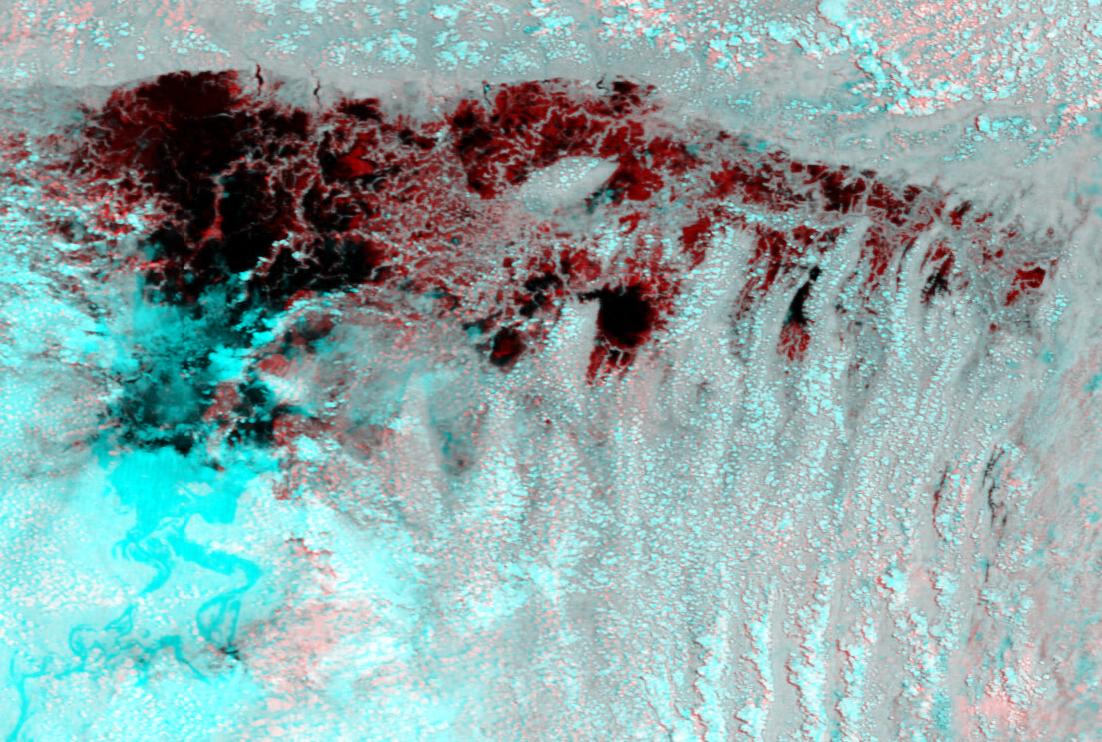







On 09 September 2024 at 06:00, Typhoon YAGI passed over central and northern Philippines, Hainan island and Guangdong province, southern China, and northernVietnam and caused large rainfall, floods and landslides that have resulted in many casualties. The combined effects of the monsoon and tropical disturbances have caused flooding and flash floods in northern Laos and Thailand. In Vietnam, the authorities have reported, as of 11 September, 127 fatalities, approximately 54 people still missing, more than 750 injured and over 52,000 evacuated people across northern provinces. Quang Ninh and Hai Phong provinces are the worst affected. Three provinces have declared emergencies: Lao Cai, Tuyen Quang and Yen Bai. UNICEF-supported facilities hosting a range of activities for children — were also flooded and partially damaged. See also https://en.wikipedia.org/wiki/Typhoon_Yagi.
Multi-temporal color composite, showing normal monsoonal flooding in black and unusual flooding in red. Fllood image date:: June 26, 2024; comparison image August 5, 2021. NASA MODIS Terra Band 2 false color composite., Geotif version available upon request: Robert.Brakenridge@Colorado.edu

Unusual flooding, June 26, 2024 in red, mean annual flood in light blue, and permanent surface water, dark blue. Red flood layer is also available as a .shp file.

June 26, 2024: two sample views below of the Google Earth kmz file available here. In these examples, the unusual flooding is shown in blue; the flood information is from the above.


MODIS-based flood map from 26 June, courtesy Dr. Dan Slayback, NASA GSFC. Left: shows both 1 and 2-day products. 2-day includes observations from 25 June, and is less likely to have cloud shadow false-positives. Flooding is in red for 1-day product. On right, and background on left, is the frequency of water detection (flood or not) over 11 years from MODIS information, with the GFPlain 250 floodplain dataset also shown for reference.

Two screenshots from the latest Sentinel 1 acquisitions over the area as processed by the CEMS Global Flood Monitoring (24 June and 22 June). Courtesy Peter Salomon at the European Commission/JRC. Access and download the CEMS GFM maps via the CEMS GloFAS map viewer and also via an API (https://extwiki.eodc.eu/en/GFM )
CEMS. GFM flood map for 24 June 2024. Magenta: flooded areas - dark blue: permanent water - lighter blue: seasonal water for current month.

CEMS GFM flood map for 22 June 2024 - (Magenta: flooded areas - dark blue: permanent water - lighter blue: seasonal water for current month)
.png)
Merged floodwater inundation June 18-24, using RAPID system derived from Sentinel-1 SAR, Courtesy “Henry” Qing Yang, Ph.D., School of Freshwater Sciences, University of Wisconsin-Milwaukee. Red: floodwater. Blue: reference permanent water. Please also find the raster files in Geotiff formats from:
https://rapid-nrt-flood-maps.s3.amazonaws.com/Global_Flood_Event/Bangladesh_2024/RAPID_Bangladesh_Jun18-24_2024.zip.

The screenshot below is flood depth for June 19, which is based on one Sentinel-1 scene that covered the main flooded areas in Bangladesh and Copernicus GlO-30 topography. Courtesy Dan Tian and Prof. Sagy Cohen at the University of Alabama
.png)
River Watch time series of discharge at SGR 31238; location shown in second graphic provided at top of this page. On June 24 at this location, discharge and flooding was only at about the normal (r=1.5 year level). However, comparison of the June 26 MODIS image to August 5, 2021 MODIS image indicated the red areas (top two images), indicating that higher-than-normal flooding is underway.

This event was selected for Observatory production of map and GIS data products. Updating of the Flood Event Archive has been discontinued; 2024 events are designated by year and geographic area.
We anticipated adding further maps. NASA Landsat 8 and Copernicus/ESA Sentinel SAR data if used are obtained from the the U.S. Geological Survey Hazards Data Distribution System. and the Sentinels Science Data hub, respectively. Landsat 8 is jointly managed by NASA and the United States Geological Survey. Copernicus is supported by the European Commission. MODIS data are obtained from the NASA NRT Global Flood Mapping facility (surface water extents) and from NASA Worldview (image files); SUOMI/VIIRS image data are also retrieved from NASA Worldview.
Flood extent files (Shp or Mapinfo) and geotif files supporting this Flood Event Map can be located here after user request.
These files may include high spatial resolution mapping such as from Sentinel or Landsat, or lower resolution files from MODIS. File names commonly include the sensor source (e.g., S1 for Sentinel 1, LS8 for Landsat, MODIS, Aqua, or Terra for MODIS) and the image date.
The Dartmouth Flood Observatory was founded in 1993 at Dartmouth College, Hanover, NH USA and moved to the University of Colorado, INSTAAR, CSDMS in 2010. The institutional support of both universities is gratefully acknowledged. The present work is supported via a NASA grant to F. Policelli, Principal Investigator, NASA GSFC.
(counting since July 26, 2024)